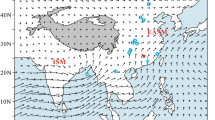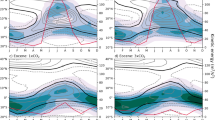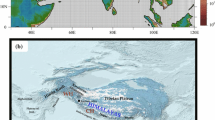Abstract
The mid-Pliocene warm period was the most recent geological period in Earth’s history that featured long-term warming. Both geological evidence and model results indicate that East Asian summer winds (EASWs) strengthened in monsoonal China, and that East Asian winter winds (EAWWs) weakened in northern monsoonal China during this period, as compared to the pre-industrial period. However, the corresponding mechanisms are still unclear. In this paper, the results of a set of numerical simulations are reported to analyze the effects of changed boundary conditions on the mid-Pliocene East Asian monsoon climate, based on PRISM3 (Pliocene Research Interpretation and Synoptic Mapping) palaeoenvironmental reconstruction. The model results showed that the combined changes of sea surface temperatures, atmospheric CO2 concentration, and ice sheet extent were necessary to generate an overall warm climate on a large scale, and that these factors exerted the greatest effects on the strengthening of EASWs in monsoonal China. The orographic change produced significant local warming and had the greatest effect on the weakening of EAWWs in northern monsoonal China in the mid-Pliocene. Thus, these two factors both had important but different effects on the monsoon change. In comparison, the effects of vegetational change on the strengthened EASWs and weakened EAWWs were relatively weak. The changed monsoon winds can be explained by a reorganization of the meridional temperature gradient and zonal thermal contrast. Moreover, the effect of orbital parameters cannot be ignored. Results showed that changes in orbital parameters could have markedly affected the EASWs and EAWWs, and caused significant short-term oscillations in the mid-Pliocene monsoon climate in East Asia.
Similar content being viewed by others
References
An, Z. S., J. E. Kutzbach, W. L. Prell, and S. C. Porter, 2001: Evolution of Asian monsoons and phased uplift of the Himalaya-Tibetan plateau since Late Miocene times. Nature, 411, 62–66.
Chandler, M., D. Rind, and R. Thompson, 1994: Joint investigations of the middle Pliocene climate II: GISS GCM northern hemisphere results. Global and Planetary Change, 9, 197–219.
Ding, Z. L., S. L. Yang, J. M. Sun, and T. S. Liu, 2001: Iron geochemistry of loess and red clay deposits in the Chinese Loess Plateau and implications for long-term Asian monsoon evolution in the last 7.0 Ma. Earth and Planetary Science Letters, 185, 99–109.
Dolan, A. M., A. M. Haywood, D. J. Hill, H. J. Dowsett, S. J. Hunter, D. J. Lunt, and S. J. Pickering, 2011: Sensitivity of Pliocene ice sheets to orbital forcing. Palaeogeogr. Palaeoclimatol. Palaeoecol., 309, 98–110.
Dowsett, H. J., and M. M. Robinson, 2009: Mid-Pliocene equatorial Pacific sea surface temperature reconstruction: A multiproxy perspective. Philos. Trans. Roy. Soc. A, 367, 109–125.
Dowsett, H. J., and Coauthors, 2010: The PRISM3D paleoenvironmental reconstruction. Stratigraphy, 7, 123–139.
Dowsett, H. J., and Coauthors, 2013: Sea surface temperature of the mid-Piacenzian ocean: A data-model comparison. Scientific Reports, 3, doi:10.1038/srep02013.
Fang, X., Z. Zhao, J. Li, and M. Yan, 2005: Magnetostratigraphy of the late Cenozoic Laojunmiao anticline in the northern Qilian Mountains and its implication for the northern Tibetan Plateau uplift. Science China Earth Sciences, 48, 1040–1051.
Ge, J. Y., and Coauthors, 2013: Major changes in East Asian climate in the mid-Pliocene: Triggered by the uplift of the Tibetan Plateau or global cooling?. Journal of Asian Earth Sciences, 69, 48–59.
Haywood, A. M., and P. J. Valdes, 2004: Modelling Pliocene warmth: Contribution of atmosphere, oceans and cryosphere. Earth and Planetary Science Letters, 218, 363–377.
Haywood, A. M., and Coauthors, 2010: Pliocene Model Intercomparison Project (PlioMIP): Experimental design and boundary conditions (Experiment 1). Geoscientific Model Development, 3, 227–242.
Haywood, A. M., and Coauthors, 2013a: On the identification of a Pliocene time slice for data-model comparison. Philos. Trans. Roy. Soc. A, 371, doi: 10.1098/rsta.2012.0515.
Haywood, A. M., and Coauthors, 2013b: Large-scale features of Pliocene climate: Results from the Pliocene Model Intercomparison Project. Climate of the Past, 9, 191–209.
Jiang, D., 2013: Vegetation feedback at the mid-Pliocene. Atmospheric and Oceanic Science Letters, 6, 320–323.
Jiang, D., H. J. Wang, Z. L. Ding, X. M. Lang, and H. Drange, 2005: Modeling the middle Pliocene climate with a global atmospheric general circulation model. J. Geophys. Res., 110, doi:10.1029/2004JD005639.
Jiang, H. C., and Z. L. Ding, 2010: Eolian grain-size signature of the Sikouzi lacustrine sediments (Chinese Loess Plateau): Implications for Neogene evolution of the East Asian winter monsoon. Geological Society of America Bulletin, 122, 843–854.
Lawrence, D. M., and Coauthors, 2011: Parameterization improvements and functional and structural advances in version 4 of the Community Land Model. Journal of Advances in Modeling Earth Systems, 3, doi:10.1029/2011MS000045.
Li, J., X. Fang, C. Song, B. Pan, Y. Ma, and M. Yan, 2014: Late Miocene-Quaternary rapid stepwise uplift of the NE Tibetan Plateau and its effects on climatic and environmental changes. Quaternary Research, 81, 400–423.
Lu, H., X. Wang, and L. Li, 2010: Aeolian sediment evidence that global cooling has driven late Cenozoic stepwise aridification in central Asia. Geological Society, London, Special Publications, 342, 29–44.
Lunt, D. J., A. M. Haywood, G. A. Schmidt, U. Salzmann, P. J. Valdes, H. J. Dowsett, and C. A. Loptson, 2012: On the causes of mid-Pliocene warmth and polar amplification. Earth and Planetary Science Letters, 321–322, 128–138.
Neale, R. B., J. Richter, S. Park, P. H. Lauritzen, S. J. Vavrus, P. J. Rasch, and M. Zhang, 2013: The mean climate of the Community Atmosphere Model (CAM4) in forced SST and fully coupled experiments. J. Climate, 26, 5150–5168.
Salzmann, U., A. M. Haywood, D. J. Lunt, P. J. Valdes, and D. J. Hill, 2008: A new global biome reconstruction and data-model comparison for the middle Pliocene. Global Ecology and Biogeography, 17, 432–447.
Salzmann, U., and Coauthors, 2013: Challenges in quantifying Pliocene terrestrial warming revealed by data-model discord. Nature Climate Change, 3, 969–974.
Shields, C. A., D. A. Bailey, G. Danabasoglu, M. Jochum, J. T. Kiehl, S. Levid, and S. Park, 2012: The low-resolution CCSM4. J. Climate, 25, 3993–4014.
Sloan, L. C., T. J. Crowley, and D. Pollard, 1996: Modeling of middle Pliocene climate with the NCAR GENESIS general circulation model. Marine Micropaleontology, 27, 51–61.
Sohl, L. E., M. A. Chandler, R. B. Schmunk, K. Mankoff, J. A. Jonas, K. M. Foley, and H. J. Dowsett, 2009: PRISM3/GISS topographic reconstruction. U.S. Geological Survey Data Series, No. 419, 6 pp.
Sun, D. H., R. X. Su, J. Bloemendal, and H. Y. Lu, 2008: Grainsize and accumulation rate records from Late Cenozoic aeolian sequences in northern China: Implications for variations in the East Asian winter monsoon and westerly atmospheric circulation. Palaeogeogr. Palaeoclimatol. Palaeoecol., 264, 39–53.
Sun, Y., G. Ramstein, C. Contoux, and T. J. Zhou, 2013: A comparative study of large-scale atmospheric circulation in the context of a future scenario (RCP4.5) and past warmth (mid-Pliocene). Climate of the Past, 9, 1613–1627.
Wan, S. M., A. C. Li, P. D. Clift, and J. B. W. Stuut, 2007: Development of the East Asian monsoon: Mineralogical and sedimentological records in the northern South China Sea since 20 Ma. Palaeogeogr. Palaeoclimatol. Palaeoecol., 254, 561–582.
Willeit, M., A. Ganopolski, and G. Feulner, 2013: On the effect of orbital forcing on mid-Pliocene climate, vegetation and ice sheets. Climate of the Past, 9, 1749–1759.
Xiong, S. F., Z. L. Ding, and S. L. Yang, 2001: Abrupt shifts in the late Cenozoic environment of north-western China recorded in loess-palaeosol-red clay sequences. Terra Nova, 13, 376–381.
Yan, Q., Z. S. Zhang, H. J. Wang, D. Jiang, and W. P. Zheng, 2011: Simulation of sea surface temperature changes in the middle Pliocene warm period and comparison with reconstructions. Chinese Science Bulletin, 56, 890–899.
Yan, Q., Z. S. Zhang, and Y. Q. Gao, 2012: An East Asian monsoon in the mid-Pliocene. Atmospheric and Oceanic Science Letters, 5, 449–454.
Zhang, P. Z., P. Molnar, and W. R. Downs, 2001: Increased sedimentation rates and grain sizes 2–4 Myr ago due to the influence of climate change on erosion rates. Nature, 410, 891–897.
Zhang, R., and D. Jiang, 2014: Impact of vegetation feedback on the mid-Pliocene warm climate. Adv. Atmos. Sci., 31, 1407–1416, doi: 10.1007/s00376-014-4015-5.
Zhang, R., and Coauthors, 2013a: Mid-Pliocene East Asian monsoon climate simulated in the PlioMIP. Climate of the Past, 9, 2085–2099.
Zhang, R., D. Jiang, Z. Zhang, and E. Yu, 2015: The impact of regional uplift of the Tibetan Plateau on the Asian monsoon climate. Palaeogeogr. Palaeoclimatol. Palaeoecol., 417, 137–150.
Zhang, Z. S., and Coauthors, 2013b: Mid-Pliocene Atlantic meridional overturning circulation not unlike modern. Climate of the Past, 9, 1495–1504.
Zheng, H. B., C. M. Powell, and Z. S. An, 2000: Pliocene uplift of the northern Tibetan Plateau. Geology, 28, 715–718.
Author information
Authors and Affiliations
Corresponding author
Rights and permissions
About this article
Cite this article
Zhang, R., Jiang, D. & Zhang, Z. Causes of mid-Pliocene strengthened summer and weakened winter monsoons over East Asia. Adv. Atmos. Sci. 32, 1016–1026 (2015). https://doi.org/10.1007/s00376-014-4183-3
Received:
Revised:
Accepted:
Published:
Issue Date:
DOI: https://doi.org/10.1007/s00376-014-4183-3




